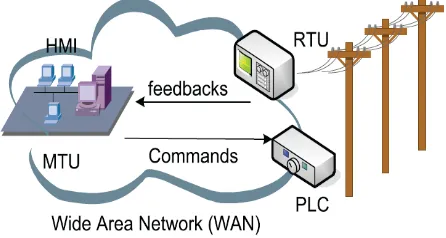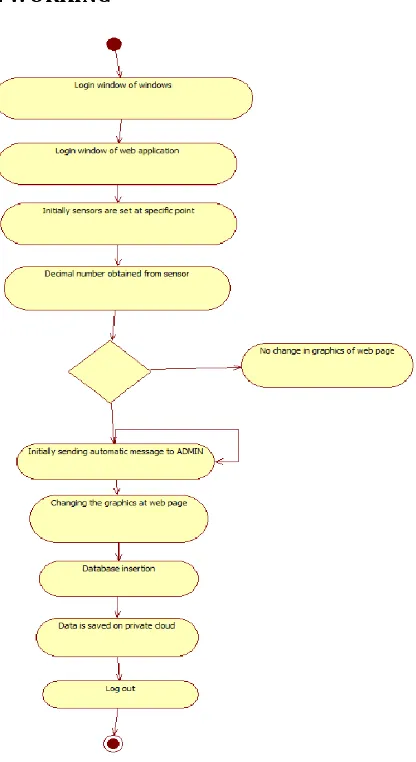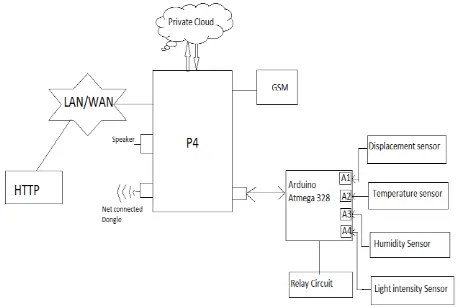© 2016, IRJET | Impact Factor value: 4.45 | ISO 9001:2008 Certified Journal | Page 2205
Implementation of SCADA Like Architecture on Web Application
Nisha Bairagi
1, Komal Gangurde
2, Priti Mokal
3, Nikita Surwade
4, Prof. P. P. Shinde
51,2,3,4
U. G. Student, Department of Computer Engineering,
NDMVP Samaj's, KBTCOE, Nashik (India)
5
Prof., Department of Computer Engineering,
NDMVP Samaj's, KBTCOE, Nashik (India)
---***---Abstract—
The SCADA System is widely used nowadays to monitor and control the hardware components in industrial setting. Traditionally, SCADA Systems are deployed in a monolithic way with a central data center and with a large amount of wiring required to connect different hardware components with the data center, the limitations of this system is that the range is 1200 meters only and cost is also very high. Security becomes major issue. Recently, WSAN technology has been used to monitor Critical Infrastructure (CIs).Keywords— Critical Infrastructure (CI) Monitoring, Remote Monitoring, Supervisory Control and Data Acquisition (SCADA) System, Wireless Sensor and Actuators Networks (WSAN), Cloud Computing, Alarm Handling, Automatic Message Sending
1. INTRODUCTION
Security and Management are two very important issues nowadays. Maintaining security and managing each and every thing in each and every field in the world. We planned to do our project to maintain security and proper management in the large scale industries. The existing SCADA System is only windows based SCADA System we cannot access that system through outside the industry. It requires too much wired connection, hardware which is too costly and limitation is only 1200 meters. It uses MODBUS protocol. Cost of this application is also very high There are some generations of the SCADA System these are as follows : First Generation: Monolithic
Second Generation: Distributed Third Generation: Networked
Fourth Generation: Internet of Things.
So, we decided to make the use of fourth generation i.e. Internet of things and also web technology, cloud computing instead of using only windows based SCADA. This project is cost effective. In our project Implementation of SCADA like Architecture on web we use HTTP protocol which is used to transferring the files (text, graphics images, sound, audio, video etc.) on web. We create one GUI (Graphical User Interface) where when changing the graphics at web page as per crossing of respective set points. It also automatically sends message to the admin. The admin has right to check the history which is stored on private cloud. It is cost effective also. There will be a day when the SCADA is operated by mobile phones. So, keeping the idea in our mind, we researched on the project and developed it using Asp.net, VB.net, SQL Server, and C++.
1.1 SCADA
© 2016, IRJET | Impact Factor value: 4.45 | ISO 9001:2008 Certified Journal | Page 2206 deployment flexibility, have the potential to become an
integral part of CIM. Their distributed and self-organizing nature makes them particularly resistant to failures and attacks as they are more rarely affected in their entirety, unlike wired systems. In addition, the ability to extend the radio range through multihop communications can be used to extend the reach of CIM systems by monitoring more points of interest in wider deployment areas.
However, in order to take advantage of WSAN, traditional SCADA acquisition processes need to change in order to accommodate this new technology. For example, secure ways of delivering information from the sensors to the centralized SCADA must be implemented. Furthermore, SCADAs normally integrate proprietary protocols, which make the integration with a general purpose WSAN non-straightforward, requiring the use of gateways. Also, quality of service (QoS) for real-time communications and management support in a WSAN are challenges that have to be considered. To tackle all these issues and to propose a generic solution to the integration problem between WSANs and SCADA was, in fact, one of the goals of the European project WSAN4CIP [8], in the context of which the solution presented in this paper has been developed. The WSAN4CIP project globally aimed to protect CIs by means of a secure WSAN system architecture. In this paper, we present the solution developed for SCADAWSAN integration. The solution is based on the use of open protocols that work over conventional networks, such as the Internet. More specifically, the system uses Internet protocol (IP) and Web services together with an open-source and Web-based SCADA called Mango. Two proof-of-concept demonstrators were deployed in WSAN4CIP, one for monitoring drinking water distribution pipelines and the other for monitoring an electrical power grid. This paper only focuses on the approach followed to integrate SCADA and WSAN and the way it has been applied to the latter demonstrator, henceforth designated the Energies de Portugal (EDP) demonstrator, which reflects the name (EDP) of the electricity distribution company. A detailed description of the WSAN4CIP overall architecture and of the WSAN wireless modules and protocols can be found in.
1.2 System Architecture
In this the first and major step is that we created the three login forms. First is for operator which has right to monitoring the system. The second form is for Manager which has right to set the parameters at some initial point, monitor the page and control the parameters. The third form
[image:2.595.320.543.425.544.2]is for owner of the industry we called it as Admin.The Admin gives or grants the permissions to the Management staff. The Admin can seen the history of the database stored on the cloud, also he can monitor the page, gives the order to management staff. Initially, we monitorsome physical parameters through sensors like temperature, light intensity, humidity and displacement sensors. We set them at some initial set point. When temperature goes above the set point it turns the fan. When light intensity goes above the set point it get turn ON. When all these parameters goes above the set point the alarm get buzzed and the system will automatically sends the message to the Admin. When humidity goes above the set point it opens the windows. All this functionality we can view on the Web Application. The below figure shows the typical architecture of the SCADA system. The RTU (Remote Terminal unit) receives the signal or data from the remote locations. Then the HMI (Human machine Interface) unit takes that data or signals from the Remote Terminal unit acquire the data , proceed that data and gives that data to PLC i.e. Programmable Logic Circuit using MTU (Master Terminal Unit). The MTU acts as a master and the RTU acts as a slave. The PLC proceed the data or signals using commands and shows the output in the form of pictures, images, curves, graphs or histogram. They calculate physical parameters such as humidity, temperatures etc. All the acquired data will be stored on the private cloud which can be viewed only by the Admin.
Fig. 1 : Typical Architectural View of SCADA System
2. PROBLEM STATEMENT
© 2016, IRJET | Impact Factor value: 4.45 | ISO 9001:2008 Certified Journal | Page 2207 important to keep watch on real time picture of industrial
environment.
3. GOALS AND OBJECTIVES
To collect, continuously monitor and store the environmental parameters values in the database. Fire a proper control action based on the set points. Provide security by proper authentication.
Web based monitoring.
SMS sending facility to authenticated person using Web API.
[image:3.595.44.252.268.649.2]4. WORKING
Fig. 2 : Activity Flowchart
Designing data is about discovering and completely defining application’s data characteristics and processes. Data design is a process of gradual refinement, from the coarse ”What data does your application require?” to the precise data
structures and processes that provide it. With a good data design, your application’s data access is fast, easily maintained, and can gracefully accept future data enhancements. The process of data design includes identifying the data, defining specific data types and storage mechanisms, and ensuring data integrity by using business rules and other run-time enforcement mechanisms.
Web based development is important to keep watch on real time picture of industrial environment. So, we not only create the windows based application but also the Web based application too. Wireless sensor and actuator networks (WSAN) constitute an emerging technology with multiple applications in many different fields. Due to the features of WSAN (dynamism, redundancy, fault tolerance, and self-organization), this technology can be used as a supporting technology for the monitoring of critical infrastructures (CIs). This uses the HTTP protocol to access it wirelessly or send or receive the file through internet. For decades, the monitoring of CIs has centered on supervisory control and data acquisition (SCADA) systems, where operators can monitor and control the behavior of the system. The reach of the SCADA system has been hampered by the lack of deployment flexibility of the sensors that feed it with monitoring data. The integration of a multihop WSAN with SCADA for CI monitoring constitutes a novel approach to extend the SCADA reach in a cost-effective way, eliminating this handicap. However, the integration of WSAN and SCADA presents some challenges which have to be addressed in order to comprehensively take advantage of the WSAN features. All the acquired data is stored on cloud which can be viewed by the Admin, he also can view the full history of the acquired data.
[image:3.595.331.520.499.652.2]© 2016, IRJET | Impact Factor value: 4.45 | ISO 9001:2008 Certified Journal | Page 2208 Fig. 4 : Functional View (UDL Diagram) of Proposed System
5. ADVANTAGES
Saves Time and Money- As the SCADA architecture give the ability to the owner to keep a track on theinfrastructure from remote place, so the time of the owner is saved and the system is web based, hence money is saved.
Less traveling for workers –The managers and scada operators should not have to travel to the infrastructure as the SCADA system is web based and can be accessed from anywhere.
Reduces man-power needs- The full working of the infrastructure is managed by the SCADA system hence the need of man power is reduced to a great extent.
Increases production efficiency of a company- The infrastructure is always kept under control hence provides a best production efficiency to the company.
Reliable- The Scada system is reliable is nature. Supervisory control over a particular system- In
Scada system system, there is a supervisory control over each and every module of the system.
6. APLLICATIONS
Water and Wastewater Industries
E-Road
Power Generation and distribution cells Oil and Gas
Transportation
Security systems
Siren systems
Irrigation
7. FUTURE SCOPE
Today, both public and private sector organizations are under greater pressure to provide increasing quality of service under ever tightening budgets Also, governmental regulations require stricter monitoring, greater energy efficiencies and detailed reporting. In this challenging environment, the organization’s supervisory control and data acquisition (SCADA) system offers new and exciting means to wring additional benefits out of approve workhorse. To understand the potential of SCADA, we must look beyond its traditional roots as a simple human-machine interface (HMI), a method to convey low-level process data to the operations team. Indeed, some see the user interface alone as the SCADA system, with little understanding of its many vital components (instrumentation, control devices, software algorithms, communications and integration services.) While the HMI continues to be an integral part of the system, its relative value as a SCADA component has been declining continuously as new value-added benefits have become financially more attainable. As a result of this increase in affordability, larger and more complex SCADA systems have arisen.
© 2016, IRJET | Impact Factor value: 4.45 | ISO 9001:2008 Certified Journal | Page 2209
8. CONCLUSION
The Costs for basic SCADA components are expected to continue to decline in the future. This trend will support SCADA use in organizations with assets of lower individual value, leading to larger, more dispersed SCADA systems. Simultaneously, larger organizations will take advantage of the growing number of value-priced, wide-area communications options to interconnect geographically dispersed SCADA and business systems. SCADA software developers must understand how to leverage new technological advances in communications without excluding legacy systems. Low-level SCADA integration will be simplified. The size and complexity of SCADA will increase at an accelerating rate, requiring the creation of tools and integration methods that provide fast, error-free replication for common SCADA tasks. Successful cooperation between vendors will be essential in providing the maximum benefit to the customer. Finally, the SCADA system will function more and more as a large control loop, able to operate autonomously at increasingly higher levels, based on fewer inputs from operational personnel. Optimization methodologies will be applied in a myriad of situations, allowing organizations to develop larger SCADA systems without incurring unreasonable operational costs or significant staffing increases. As such, the value of the pure HMI component of SCADA software, as we know it today, will decline relative to the many other emerging benefits SCADA systems will offer.
9.


